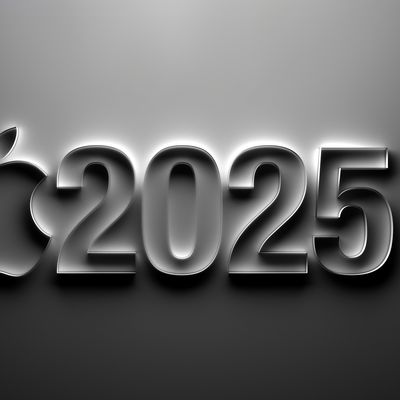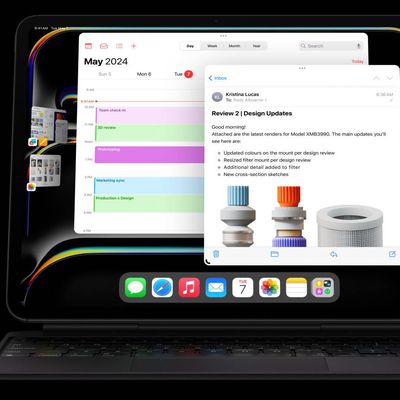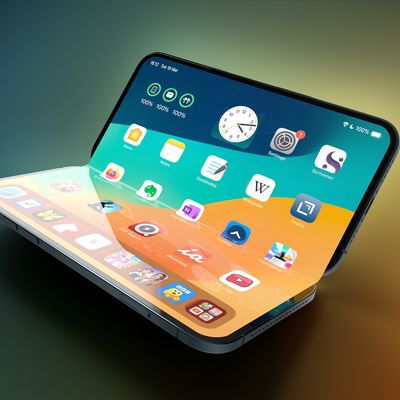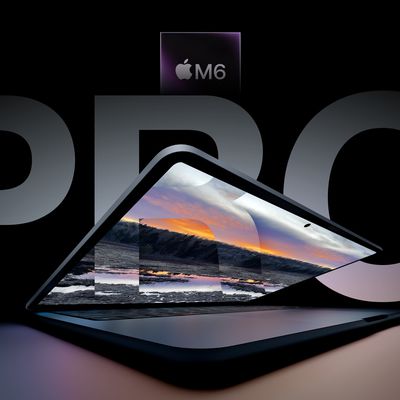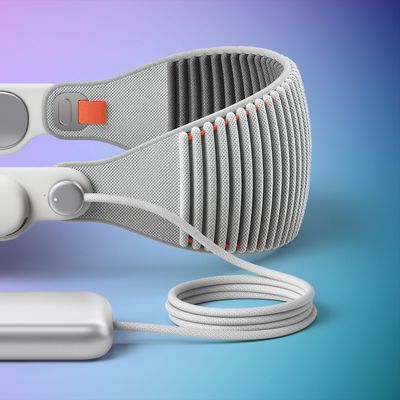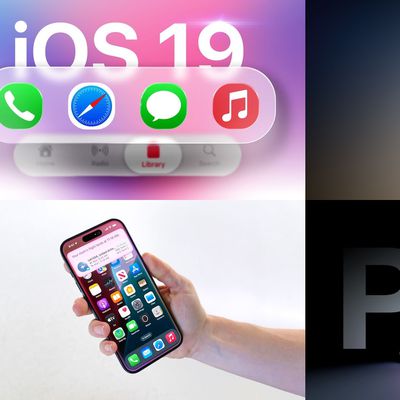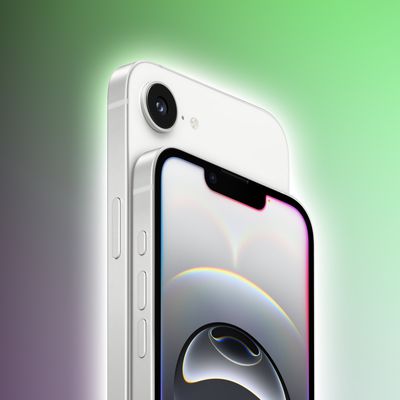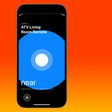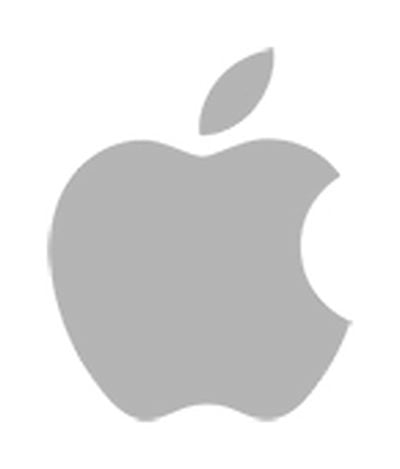 Apple today announced financial results for the third calendar quarter and fourth fiscal quarter of 2017.
Apple today announced financial results for the third calendar quarter and fourth fiscal quarter of 2017.
For the quarter, Apple posted revenue of $52.6 billion and net quarterly profit of $10.7 billion, or $2.07 per diluted share, compared to revenue of $46.9 billion and net quarterly profit of $9 billion, or $1.67 per diluted share, in the year-ago quarter. The revenue and earnings per share numbers were company records for the fourth fiscal quarter, although the total profit fell short of the 2015 figure.
Gross margin for the quarter was 37.9 percent, compared to 38 percent in the year-ago quarter, with international sales accounting for 62 percent of revenue. Apple also declared an upcoming dividend payment of $0.63 per share, payable November 16 to shareholders of record as of November 13.
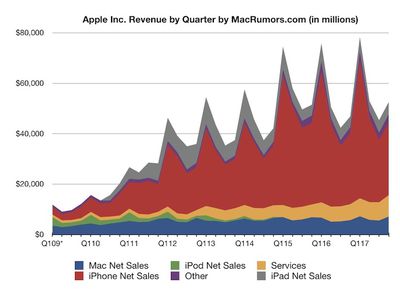
For the quarter, Apple sold 46.7 million iPhones, up from 45.5 million in the year-ago quarter. iPad sales were up to 10.3 million from 9.3 million in the fourth quarter of 2016, and Mac sales rose to 5.4 million from 4.9 million.
For the full fiscal year, Apple generated $229.2 billion in sales with $48.4 billion in net income, up from $215.6 billion in sales and $45.7 billion in net income for fiscal 2016.
“We’re happy to report a very strong finish to a great fiscal 2017, with record fourth quarter revenue, year-over-year growth for all our product categories, and our best quarter ever for Services,” said Tim Cook, Apple’s CEO. “With fantastic new products including iPhone 8 and iPhone 8 Plus, Apple Watch Series 3, and Apple TV 4K joining our product lineup, we’re looking forward to a great holiday season, and with the launch of iPhone X getting underway right now, we couldn’t be more excited as we begin to deliver our vision for the future with this stunning device.”
Apple's guidance for the first quarter of fiscal 2018 includes expected revenue of $84-87 billion and gross margin between 38 and 38.5 percent.
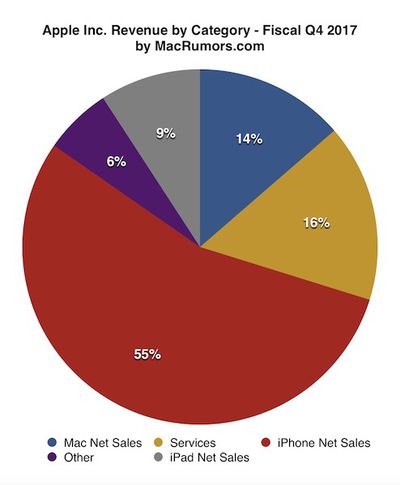
Apple will provide live streaming of its fiscal Q4 2017 financial results conference call at 2:00 PM Pacific, and MacRumors will update this story with coverage of the conference call highlights.
A complete transcript of Apple's fourth quarter earnings call is ahead.
Tim Cook
Good afternoon and thanks to everyone for joining us. As we close the books on a very successful fiscal 2017, I have to say I couldn't be more excited about Apple's future.
This was our biggest year ever in most parts of the world, with all-time record revenue in the United States, Western Europe, Japan, Korea, the Middle East, Africa, Central and Eastern Europe, and Asia. We had a particularly strong finish this year, generating our highest September quarter revenue ever, as year-over-year growth accelerated for the fourth consecutive quarter.
Revenue was $52.6 billion, above the high end of our guidance range, and up 12 percent over last year. We generated revenue growth across all of our product categories, and showed all-time record results for our services business. As we expected, we returned to growth in Greater China, with unit growth and market share gains for iPhone, iPad, and Mac. In fact, it was an all-time record quarter for Mac sales in mainland China, as well as an all-time high for services revenue. And revenue from emerging markets outside Greater China was up 40 percent, with great momentum in India, where revenue doubled year over year. We also had great results in enterprise and education, with double digit growth in worldwide customer purchases of iPad and Mac in both markets. Gross margin for the September quarter was at the high end of our guidance range, and thanks to exceptional work by our teams, we generated record fourth quarter earnings per share of $2.07, up 24 percent from a year ago.
iPhone sales exceeded our expectations. In the last week and a half of September, we began shipping iPhone 8 and iPhone 8 Plus to customers in more than 50 countries. They instantly became our two most popular iPhone models, and have been every week since then. As we speak, the launch of iPhone X is now underway, as stores open across Australia and Asia. iPhone X is packed with innovative, new technologies that chart our path for the next decade. Technologies like the TrueDepth camera system, Super Retina Display, and A11 Bionic chip with neural engine, which has been in development for years with a focus on deep machine learning. iPhone X enables totally new experiences, like unlocking your iPhone with Face ID, taking photos with studio-quality lighting effects, or playing immersive augmented reality games. We can't wait for people to experience our vision of the future. Orders have already been very strong, and we're working to get iPhone X into customers' hands as quickly as possible.
Turning to services, revenue reached an all-time quarterly record of $8.5 billion in the September quarter. A few quarters ago, we established a goal of doubling our fiscal 2016 services revenue of $24 billion by the year 2020, and we are well on our way to meeting that goal. In fiscal 2017, we reached $30 billion, making our services business already the size of a Fortune 100 company.
We're also delighted to report our second consecutive quarter of double-digit unit growth for iPad. Customers have responded very positively to the new iPad lineup, and with the launch of iOS 11, the iPad experience has become more powerful than ever, with great new features for getting things done, like the new Dock, Files app, Drag and Drop, multitasking, and more power than most PC notebooks.
The launch of iOS 11 also made iOS the world's largest platform for augmented reality. There are already over 1,000 apps with powerful AR features in our App Store today, with developers creating amazing news experiences in virtually every category of apps, aimed at consumers, students, and business users alike. Simply, we believe AR is going to change the way we use technology forever. We're already seeing things that will transform the way you work, play, connect, and learn. For example, there are AR apps that let you interact with virtual models of everything you can imagine, from the human body to the solar system. And of course, you experience them like they're really there. Instantly, education becomes much more powerful, when every subject comes to life in 3D. And imagine shopping, when you can place an object in your living room before you make a purchase. Or attending live sporting events, when you can see the stats on the field. AR is going to change everything. iOS 11 is also allowing developers to integrate machine learning models into their apps with CoreML. Pinterest is already using CoreML to deliver fast and powerful visual search. PadMapper uses CoreML to provide intelligent features that make it easy to find or rent your apartment. These are just a few examples. There's so much more to come.
Next I'd like to talk about the Mac, which had its best year ever, with the highest annual Mac revenue in Apple's history. It was also the best September quarter ever with Mac revenue growth of 25 percent, driven by the notebook refreshes and a strong back to school season. The Mac experience has become even better since the September launch of macOS High Sierra, with new technologies to make Mac more reliable, capable, and responsive, and lay the foundation for future innovation.
Moving on now to Apple Watch, with unit growth of over 50 percent for the third consecutive quarter, it continues to be the best selling and most loved smartwatch in the world. We began shipping Apple Watch Series 3 just six weeks ago, and customers love the new freedom of cellular. The ability to go for a run with just your Apple Watch, or go for a quick errand without your phone, while staying connected, is a game changer. Now more than ever, Apple Watch is the ultimate device for healthy life, and is already making a big difference in our customers' lives. We're very excited about the upcoming launch of the Apple Watch heart study, which will use data from Apple Watch to identify irregular heart rhythms and notify users when unusual patterns are detected. Earlier this week, we introduced watchOS 4.1, bringing 40 million songs to your wrist through Apple Music. The combination of music streaming on Apple Music and AirPods is truly a magical experience for people on the go. We're thrilled with the momentum of these products. In fact, our entire wearables business was up 75 percent year over year in the fourth quarter, and in fiscal 2017, already generated the annual revenue of a Fortune 400 company.
Late in the September quarter, we also launched Apple TV 4K, delivering a stunning cinematic experience at home. So now users around the world can watch movies and shows in 4K HDR quality and stream live sports and news on the Apple TV app. There's already a great selection of 4K HDR titles available through iTunes, and other popular video services, with many more movies and shows on the way.
We're also very excited about the opening of Apple Michigan Avenue two weeks ago on Chicago's riverfront. This is the first store that brings together our complete vision for the future of Apple retail, providing a welcoming place for everyone to experience our products, services, and inspiring educational programs right in the heart of their city. In addition to our very popular Today at Apple programming, which is available in all Apple Stores around the world, offering daily sessions in photography, music creation, art and design, coding, and entrepreneurship, Apple Michigan Avenue is partnering with local non-profits and creative organizations to make an ongoing, positive impact in that community.
Also this quarter, we expanded our free App Development with Swift curriculum to more than 40 community colleges across the country. We're very excited about this initiative, and we're thrilled by the momentum we're seeing. The schools we launched with this summer are just the beginning. Community colleges have a powerful reach into communities where education is the great equalizer, and the colleges adopting our curriculum this academic year are providing opportunity to millions of students to build apps that will prepare them for careers in software development, information technology, and much more.
We're incredibly enthusiastic about what our teams have accomplished this year, and about all of the amazing products in our lineup. As we approach the holiday season, we expect it to be our biggest quarter ever. I'd like to thank all of our teams, our partners, and our customers for their passion, commitment, and loyalty. You've helped us make 2017 a sensational year.
Luca Maestri
Revenue for the September was a record $52.6 billion, up 12 percent over last year. It has been great to see our growth rate accelerate in every quarter of fiscal 2017. Our terrific performance this quarter was very broad based, with revenue growth in all of our product categories for the second quarter in a row, and new September quarter revenue records in the Americas, in Europe, and in the rest of Asia-Pacific segments. We grew double digits in the U.S., Canada, Germany, France, Italy, Spain, Korea, and several other developed markets. We were especially happy to return to growth in Greater China, where revenue was up 12 percent from a year ago, and with our momentum in India, where revenue doubled year over year. We grew more than 30 percent in Mexico, the Middle East, Turkey, and Central and Eastern Europe. These results helped fuel overall growth of over 20 percent from emerging markets.
Gross margin was 37.9 percent, at the high end of our guidance range. Operating margin was 25 percent of revenue, and net income was $10.7 billion. Diluted EPS were $2.07, up 24 percent over last year, to a new September quarter record, and cash flow operations was strong, at $15.7 billion.
During the quarter we sold 46.7 million iPhones, up 3 percent over last year. We were very pleased to see double digit iPhone growth in many emerging markets, including mainland China, the Middle East, Central and Eastern Europe, India, and Mexico. We gained share not only in those markets, but also in Canada, Germany, France, Italy, Spain, Sweden, and Singapore, based on the latest estimates from IDC. iPhone channel inventory increased by 1.3 million units sequentially to support the launch of iPhone 8 and 8 Plus, significantly less than the increase in the September quarter a year ago. Customer interest and satisfaction with iPhone are very strong, with both consumers and business users. In the U.S., the latest data from 451 Research on consumers indicates a customer satisfaction rate of 97 percent or higher across all iPhone models. Among consumers planning to buy a smartphone in the next 90 days, purchase intention for iPhone was 69 percent—more than five times the rate of the closest competitor—with a loyalty rate for current iPhone owners of 95 percent, compared to 53 percent for the next highest brand. For corporate smartphone buyers, iOS customer satisfaction was 95 percent, and of those planning to purchase smartphones in the December quarter, 80 percent plan to purchase iPhones. That is the highest score for iPhone in the history of the survey.
Turning to services, we set an all-time quarterly record of $8.5 billion, up 34 percent year over year. Our results included a favorable, one-time revenue adjustment of $640 million. On a run-rate basis, excluding this adjustment, services growth of 24 percent was terrific and the highest that we have experienced this year. The App Store set a new all-time record, and according to App Annie's latest report, it continues to the be the preferred destination for customer purchases, by a wide and growing margin, generating nearly twice the revenue of Google Play. We're getting great response to the App Store's new design in iOS 11 from both customers and developers. We're seeing increases in the frequency of customer visits, the amount of time they spend in the store, and the number of apps they download. The success of Apple Music also continues to build, and we're seeing our highest conversion rates from customers trying the service. Revenue grew strongly once again in the September quarter, and the number of paid subscribers was up over 75 percent year over year. We also saw great performance from our iCloud business, with very strong double-digit growth in both monthly average users and revenue. Across all of our services offerings, the number of paid subscriptions reached over 210 million at the end of the September quarter, an increase of 25 million in the last 90 days. Apple Pay expanded to Denmark, Finland, Sweden, and the UAE last month, and continues to grow rapidly. Over the past year, active users have more than doubled, and annual transactions are up 330 percent. In the U.S., 70 percent of leading grocery chains are now accepting Apple Pay, with the recent launch of Safeway. And over 5 million U.S. merchant locations will be Apple Pay enabled by the end of this year.
Next, I'd like to talk about the Mac, which for fiscal 2017 set a new all-time revenue record of $25.8 billion. We sold 5.4 million Macs during the September quarter, up 10 percent over last year, and gained significant market share as the global market contracted by one percent, according to IDC's latest estimate. This performance was fueled primarily by great demand for MacBook Pro, and Mac revenue grew 25 percent to a new September quarter record. We had outstanding results all around the world in each of our geographic segments, growing Mac revenue by 20 percent or more. We were also very happy with the success of Mac in the education market, where customer purchases grew double digits year over year.
It was also another great quarter for iPad—we sold 10.3 million units—up 11 percent over last year, with strong demand for both iPad and iPad Pro, and revenue grew 14 percent. It was great to see iPad unit and revenue growth in all of our geographic segments, and particularly strong results in emerging markets, including Greater China, where iPad unit sales were up 25 percent year over year, and India, which grew 39 percent. NPD indicates that iPad had 54 percent share of the U.S. tablet market in the September quarter, including seven of the best 10 selling tablets. That's up from 47 percent share a year ago. Also, the most recent surveys from 451 Research measured customer satisfaction rates of 97 percent across iPad models. And among people planning to buy tablets, purchase intent for iPad was over 70 percent for both consumers and businesses.
We are seeing great momentum with our enterprise initiatives. During the September quarter we announced a new partnership with Accenture, who is creating a dedicated iOS practice in select locations around the world. Experts from Apple are colocating with these teams, and together they will be launching new tools and services that help enterprise clients transform how they engage with customers using iPhone and iPad. Examples include services to build new customer experiences, and to facilitate iOS integration with enterprise systems, to help businesses take greater advantage of data from Internet of Things platforms, and to enable the smooth transfer of existing legacy applications and data to modern iOS apps.
And last month, we announced a partnership with GE to reinvent the way industrial companies work, by bringing GE's industrial IoT platform to iOS. The Predix SDK for iOS will enable developers to build native apps to drive industrial operations with more efficiency and speed than ever before. GE is also standardizing on iPhone and iPad for its global workforce of more than 330,000 employees. And working with Apple, GE is developing iOS apps for both its internal and external audiences to bring predictive data and analytics to workers across a broad range of industries. Beyond our iOS devices, we're also seeing great traction for Mac in the enterprise market, with all-time record customer purchases in fiscal year 2017.
The September quarter was very strong for our retail and online stores, which welcomed 418 million visitors. Traffic was particularly heavy during the week of our new product announcements, up 19 percent over last year. Retail ran a very successful Back to School promotion in the Americas, Europe, China, and Singapore. We see Mac and iPad Pro up strong double digits compared to last year's program. Around the world, our stores conducted over 200,000 Today at Apple sessions during the quarter.
Let me now turn to our cash position. We ended the quarter with $268.9 billion in cash plus marketable securities, a sequential increase of $7.4 billion. $252.3 billion of this cash—94 percent of the total—was outside the United States. We issued $7 billion in new Canadian and U.S. dollar denominated debts in the quarter, bringing us to $104 billion in term debt and $12 billion in commercial paper outstanding. We also returned $11 billion to investors during the quarter. We paid $3.3 billion in dividends and equivalents, and spent $4.5 billion on repurchases of 29.1 million Apple shares through open market transactions. We also launched a new $3 billion ASR program, resulting in initial delivery and retirement of 15.1 million shares, and we retired 4.5 million shares upon the completion of our 11th ASR during the quarter. We have now completed almost $234 billion of our $300 billion capital return program, including $166 billion in share repurchases.
As we move ahead into the December quarter, I'd like to review our outlook which includes forward-looking information. As a reminder, the December quarter in fiscal 2017 spanned 14 weeks, whereas the December quarter this year will include the usual 13 weeks. We expect revenue to be between $84 billion and $87 billion. We expect gross margin to be between 38 percent and 38.5 percent. We expect operating expenses to be between $7.65 billion and $7.75 billion. We expect other income/expenses to be about $600 million, and we expect the tax rate to be about 25.5 percent. Also today, our board of directors has declared an upcoming dividend payment of $0.63 per share of common stock, payable on November 16, 2017 to shareholders of record as of November 13, 2017.
Questions and Answers
Katy Huberty, Morgan Stanley: When do you expect to catch up with iPhone X demand? Given it's likely not to be in December quarter, do we think of March as a better-than-seasonal revenue quarter?
Tim Cook: The ramp for iPhone X is going well, especially considering that iPhone X is the most advanced iPhone we've ever created, and it has lots of technologies in it. So, we're really happy that we're able to increase week by week what we're outputting, and we're going to get as many of them as possible to the customers as soon as possible. I can't predict at this point when that balance will happen. And in terms of March, we don't give guidance beyond the current quarter.
Huberty: In China, growth returned to strong double digits–12 percent up. You've talked historically about that region being more sensitive to others to form factor changes. The new iPhone X form factor was not available in September. Should we believe that growth in that region only accelerates from here as that product gets pushed into the market?
Tim Cook: Let me talk a little about Q4 in China to give you a little bit of color on the results. We increased market share for iPhone, Mac, and iPad during the quarter. We hit all-time revenue records for services, and for Mac in the People's Republic of China during the quarter. We had very strong iPad revenue growth. We had double-digit unit growth in iPhone, and both the upgraders and Android switchers were up on a year-over-year basis in the quarter. The results were broad based. They were pretty much across the board, as I indicated. Another thing that happened is the decline we've been experiencing in Hong Kong moderated. It's still down year over year, but less so than what it was. Part of that is the compare is—easier compare. And, finally, in terms of another headwind that is a little less than it was, currency has been affecting us more significantly. Last quarter, in China, it affected us one percentage point. The sum of all of that, I feel great about the results. We don't obviously provide geographic-specific guidance, but you can see from our overall guidance, we think we're going to have a really strong quarter.
Michael Olson, Piper Jaffray: Is there any information you can provide on how iPhone X pre-orders compare to what you saw with iPhone 8 pre-orders?
Tim Cook: We never go through mix, but I can share with you that iPhone X orders are very strong for both direct customers and for our channel partners, which as you know, are lots of carriers throughout the world. We couldn't be more excited to get underway. I think as of a few minutes ago, the first sales started in Australia. I'm told we had several hundred waiting at the store in Sydney, and I'm getting similar reports from across that region.
Olson: We're excited about augmented reality. From your perspective, and maybe from our perspective on the outside looking in, how do we gauge the success of AR, and what are some of the applications of the technology that you're most excited about today?
Tim Cook: The reason I'm so excited about AR is I view that it amplifies human performance instead of isolates it. As you know, it's the mix of the virtual and the physical world. It should be a help for humanity—not an isolation kind of thing for humanity. As I go through different countries I've been traveling lately, and looking at things, some things in the market, other things that are coming, the very cool thing is they're all over the place. I see things that the consumer is going to love because it's going to change shopping. I see things that consumers will love on the gaming side, the entertainment side. I see business-related AR, apps as well, that are going to be great for productivity between large and small business. I see apps that make me want to go back to K-12 again and repeat my schooling because I think it changes the game in the classroom a lot. The real beauty here is that it's mainstream. Of course, Apple is the only company that could have brought this because it requires both hardware and software integration, and it requires making—or giving—the operating system update to many people at once. The software team worked really hard to make it go back several versions of iPhone so that we sort of have hundreds of millions of enabled enabled overnight. There's 1,000+ apps in the App Store right now. I think this is very much like in 2008 when we fired the gun in the overall App Store. And so that's what it feels like to me. I think it will just get bigger from here.
Shannon Cross, Cross Research: Can you talk a bit about how you're thinking about the lineup—this is for iPhone—you go from $349 to above $1,000. It appears you probably sold a fair amount at the lower end… but how are you sort of thinking about what went into the guidance for the December quarter? Are you seeing really strong demand at the low end, and obviously an expected benefit from the iPhone X at the high end?
Tim Cook: In terms of what we saw in Q4, you can probably tell from the ASP we had good success I would say through the different iPhones. We've tried hard to have an iPhone that is as affordable as possible for people that really want an iPhone that may have a more limited budget. We've got some iPhones that are really great for that market, and then we've got three new iPhones and people will look at these and decide which one they want. This is the first time we've ever been in the position that we've had three new iPhones at once like this, at the top end of the line, and it's the first time we've had a staggered launch. So, we're going to see what happens. We've put our absolute best thinking into the guidance that Luca presented. You can tell from that, that we're bullish.
Cross: Great, thank you. And then in terms of services—$8.5 billion, up 34 percent—can you talk about some of the portions of that that outperformed? How sustainable—you mentioned China in terms of significant growth in services. I'm just curious. That's a pretty remarkable number, so I'm curious what the drivers were.
Tim Cook: As I mentioned, in the prepared remarks, there was a $640 million adjustment—there was a one-off change, and it's important to call it out, because of course it's a one off—so the underlying growth rate for services in the quarter was fantastic—24 percent—it was the highest growth rate we've had in fiscal 2017. App Store set a new all-time record. It's going incredibly well. The number of paying accounts continues to grow very strongly, and that's very, very important to us for the App Store business. Apple Music subscriptions were up 75 percent year over year. We're getting the highest conversion rates we've had since the launch of the service. We've turned the corner in the music industry. You might remember that a few years ago we were actually declining in the music industry. Now, with the streaming service in addition to the download business, the business is growing again. That really helps the growth rate for the entire services business. iCloud is a service that continues to grow—very strong double digits—that's also helping. We've already become the size of a Fortune 100 company. We already set a goal for ourselves to double what we did in fiscal 2016, and the trajectory is actually quite positive.
Steven Milunovich, UBS: I wanted to push a little bit more on the mix, could you comment on whether the 8 Plus outsold the 8 during the quarter? There seems to be some data that suggests that. The 451 Research survey that you're alluding to also finds that, over the 90 next days, 43 percent are planning to buy the iPhone X. Can you comment on your expectations of the mix going forward, and if you won't do that, perhaps you could comment a bit about your thinking in terms of pushing pricing elasticity. I think a year ago, nobody would have imagined selling a phone for this price, and you're pretty confident that you could do it.
Tim Cook: Obviously, I'm not going to talk about mix. It's not something we've done in the past. If you look at the 8 and 8 Plus, when we launched them they instantly became our top two selling products. If you look at 8 Plus in particular to provide a little color there, 8 Plus for the period of time that we can measure to date, has gotten off to the fastest start of any Plus model. That for us was a bit of a surprise—a positive surprise obviously—and so we'll see what happens next. As I mentioned before, we've never had three products, and it's only today that customers can sort of look at all three of those, and I'm sure there's been some people that wanted to do that before even deciding which one. We'll see what happens there. In terms of price elasticity, I think it's important to remember that a large number of people pay for the phone by month, and so if you were to go out on the just the U.S., that tends to be more the focus of this call, you would look at the U.S. carriers and I think you would find you could buy an iPhone X for $33/month. So, if you think about that, that's a few coffees a week—it's less than a coffee a day at one of these nice coffee places. The other thing to keep in mind is that many people are now trading in their current iPhone on the next iPhone, and the residual value for iPhone tends to be the highest in the industry, and many people pick up $300 to $350 or so for their iPhone. So, that even reduces the monthly payment less, and then obviously, some carriers also have promotional things going on. So, I do think it's important to try to place it in that context. In terms of the way we price, we price to the value that we're providing. We're not trying to charge the highest price we could get or anything like that. We're just trying to price it for what we're delivering. iPhone X has a lot of great new technologies in there that are leading the industry and it a fabulous product. We can't wait for people to start getting it in their hands.
Milunovich: The street historically has been a little skeptical about continued innovation. You suggested there is more to go. Historically, you weren't first to large screens. You weren't first to OLED. Now though, you are leading in AR, you are leading with Face ID, which the all-in a year ago has suggested is kind of reminiscent of the aggressive Apple. Is it possible going forward that you could accelerate share gains from Android since you're now in a stronger competitive position?
Tim Cook: I think we've been in a competitive position. I probably, maybe have a different view than you do, or the folks that you're quoting. There's always doubting Thomases out there. I've been hearing those for the 20 years I've been here, and I expect I'll hear about them until my retirement. I don't really listen to that too much. There's lots of fantastic people here, and they're doing unbelievable things, and yes, I view AR as profound. Not today, not the app you'll see on the App Store, but what it will be, what it can be, I think it's profound. I think Apple is in a really unique position to lead in this area.
Toni Sacconaghi, Bernstein: You talked a bit about providing a lot of value and that Apple sets its pricing according to value. I think given the uniqueness of the product you have—the iPhone X in particular—that makes a lot of sense. I guess the question is, given the uniqueness of the value that you have in the marketplace, why shouldn't we expect gross margins to improve this cycle versus previous ones, and perhaps you can talk a little bit about how you think about pricing in the context of gross margin.
Luca Maestri: We price our products for the value that we deliver. We also said that every time we launch new products, the cost structures of the new products tend to be higher than the products that they replace. It's inevitable. We're adding new technologies, new features, and therefore the cost structures go up. We have a very good track record of taking those cost structures, and over the lifecycle of the product, we are able to bring them down. There are a lot of elements in the gross margin line that we have good control over, and there are also elements that we don't control. Take, for example, foreign exchange, which has been a significant headwind for the company for the last three years. Also, the mix of products that we sell into the market tends to change over time, and that also has an impact on the overall gross margin for the company. There are situations where the commodity markets are in good shape, there are situations where commodity markets can be a bit out of balance. We have a case right now around memory pricing, which is a headwind for the time being. So, there's many puts and takes. The fact that our services business is growing should be a positive because our services margin tend to be accretive to company margins. There are many puts and takes. We tend to think about maximizing gross margin dollars, because we think that's the most important thing for investors at the end of the day. When we look at our track record over years, I think we've found a good balance between unit growth and gross margins and revenue, and we will continue to do that as we go forward.
Sacconaghi: I wanted to revisit this notion of supply and demand. I know it's early and you can't make predictions. I think a common investor question is that the iPhone X was made for available for sale. It quickly had pushed out availability levels to unprecedented levels versus history. I think the significant question is that initial push-out a function of uniquely strong demand versus history or is that push-out in availability really a function of much weaker supply versus history?
Tim Cook: The truth is we don't know. We put our best estimate into the guidance. As you can see from the guidance, we're very bullish. We feel really great about the product lineup. We just sold the first units minutes ago, and so we'll see how things go. Until you get all of them out there, where customers have the ability to demo and so forth, I think any kind of mix discussion is very much estimating. So, we put our best estimates in—granted, we've never done this before, so there's no comparison here, with either the three iPhones or a staggered launch. So we're going to learn something.
Jim Suva, Citigroup: What would it take to be even more successful in India? Is it a manufacturing plant there with your partners? Is it more physical stores? Is it more price points? Is it that bandwidth has now caught to up to many other countries? On the AR/VR side, where will it really show up in your income? Hardware sales? Services? Where will it be monetized?
Tim Cook: In terms of India, many of the things you mentioned are correct. Growing a market like India is a result of all of those things, and doing all of them well. It's analogous to the many years we put into China—it's building stores, it's building channels, it's building markets, it's building the developer ecosystem… it's having the right product lineup for the market. I feel like we're making good progress there and are gaining understanding of the market. But we still have a long way to go, which I sort of see as an opportunity, instead of a problem. I do feel great about the growth rate. And so that's India. It's all of those things. We started manufacturing the iPhone SE there six to nine months ago or so, and the majority of iPhone SEs that we sold in the domestic market last quarter were manufactured there. And so we also have that going, and are hoping that winds up saving some amount of money over time and avoiding some of the compounding of taxes et cetera. The bandwidth issue has also been an issue, but as you point out, it is being addressed. Between the large carriers there with Bharti and now Jio investing the way they are, the service in India is materially better than it was just 12 months ago. So there's been a sea change there in a short period of time. I feel good about all of that, but we have a long way to go. In terms of the monetization question on AR/VR, we tend to focus first and foremost on customer experience. And so, we're all about making sure the experience is great. And we think if we get the experience right, that revenues and profits will be a result of getting that right. And so we're very much focused on the experience right now.
Amit Daryanani, RBC Capital Markets: I guess maybe to start with on gross margin, Luca, year over year revenues are going to be up high single digits and the midpoint. Gross margins will be down a little. Can you just talk a little, what are the puts and takes on that, and are yield and efficiencies broadly much more severe this time versus what you've seen historically?
Luca Maestri: So we guided 38 to 38.5. That's up 35 basis points sequentially. Obviously we're getting the leverage from the larger volumes. As I mentioned to Toni, we have higher cost structures every time we launch new products, so that is going to be the offset. And I mentioned particularly the impact from the memory pricing environment, which is a headwind at this point. Just to size it for you, the impact of memory on our gross margin is 40 basis points sequentially and 110 basis points on a year over year basis. So they are meaningful impacts, and I think that is what probably you're referring to.
Daryanani: Got it, that's very helpful. And if I could just follow up on the services line, you guys talked about it a fair amount earlier, but if you were to exclude the one-time gain, it looks like the back half of 2017 accelerated by 500 basis points versus the first half of 2017. Qualitatively or quantitatively, is there a way to think about how much of this is from expanding of the install base, which is one of the three things you mentioned I think, versus more dollar per iOS device that you see?
Luca Maestri: I think it's both. As I mentioned, particularly on the App Store, which is very important to us, the number of paying accounts has grown a lot. It's grown a lot because, as you said, the install base has grown, but also because we have made a number of changes that have made it easier for our customers around the world to participate on the App Store and be able to transact on the App Store. We are accepting, for example, more forms of payment than we were twelve months ago, or even six months ago. So that's been very important. We also see that there is a typical spending curve for our customers when they start transacting on the store. They start at a certain level, and they tend over time to get more familiar with the store and to start to spend more. We also now very recently made some changes, as you probably have seen, to the design of the App Store, as I was mentioning during the prepared remarks that these changes have been received very favorably, so people are now spending more time on the store, they download more apps, and that over time translates into monetization. But we also have other businesses that are growing very, very fast and are actually accelerating. I mentioned music, I mentioned iCloud, and so it all adds up, and as you correctly point out, our growth rate is accelerating.
Brian White, Drexel Hamilton: If we take a look at mainland China, and we think about iPhone 8 and iPhone 8 Plus, they've been on sale for a while now, what has been the general response to those two new iPhones, and also, pre-orders around the iPhone X in mainland China?
Tim Cook: I hate to repeat this, but we don't really disclose mix. We view it as competitive information that we want to hold tightly ourselves. In terms of the way that the pre-order process works in China in the channel—so, not in our direct channel, but in the broader carrier channel—they generally take indications of interest versus something that I would label a pre-order. So, I would hesitate to even quote a number for fear it could be misconstrued. We'll find out demand and where the supply and demand meet some time in the future. I don't know when yet. But we're really excited to get going to find out.
White: It's interesting that sales grew 16 percent sequentially. If you look at the past five years, sales were up seven percent in the September quarter, so that's an average. Yet, you didn't have all your iPhones in the market. So, if you had to, what would you attribute that to? It's a pretty big disconnect—16 percent versus an average of seven percent.
Tim Cook: Our emerging market performance during the quarter was very strong. You take China out—it's even stronger—but you can see that China rebounded. As I indicated before, the China rebound was broad based across the products. And so, we just had a phenomenal quarter on iPad, on the Mac, on services, on Apple Watch, on iPhone. I mean, we're literally firing on all cylinders. And so that, and our new products, give us great confidence headed into this holiday season that this is going to be the best holiday season yet.



